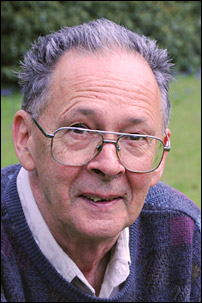Brookhaven Lab's Robert Palmer Elected Member of the National Academy of Sciences
May 6, 2008
UPTON, NY - Robert Palmer, a senior physicist and head of the Advanced Accelerator Group at the U.S. Department of Energy's Brookhaven National Laboratory, has been elected a member of the National Academy of Sciences. He is among 72 new members elected this year "in recognition of their distinguished and continuing achievements in original research." Election to the Academy is considered one of the highest honors that can be accorded a U.S. scientist.
The National Academy of Sciences is a private organization of scientists and engineers dedicated to the furtherance of science and its use for the general welfare. The Academy is, upon request, an official advisor to the federal government in any matter of science or technology.
"This is certainly not something I expected," Palmer said. "It was quite a shock when the phone brought a flood of congratulations - the official notification came long afterward. We do our science in groups and collaborations, so the honors go to more than the one elected. I offer my thanks both to those who elected me, and also to all those I have worked with and have contributed to 'our' achievements. We have had a lot of fun."
After earning a Ph.D. in physics at Imperial College, London, in 1960, Palmer joined Brookhaven Lab as a research associate. He rose through the ranks to become a senior physicist in 1974, and Associate Director for High Energy Physics Research in 1983.
From 1987 to 1990, and from 1991 to 1996, Palmer held joint appointments at Brookhaven and the Stanford Linear Accelerator Center. In 1990, he started work on magnet development at the Superconducting Super Collider. After returning to Brookhaven in 1991, Palmer was named head of the Laboratory's Center for Accelerator Physics (CAP). Currently, he is in charge of the Advanced Accelerator Group at CAP.
Palmer has made several notable discoveries in particle physics. In 1993, he shared the American Physical Society's W.K.H. Panofsky Prize with Brookhaven Lab's Nicholas Samios and Ralph Shutt for the 1962 discovery of the Omega-minus particle. Palmer was also involved in the discovery of neutral currents in the early 1970s at the European particle-physics laboratory CERN, the charmed baryon at Brookhaven in 1975, and direct single photons at CERN in 1978.
Palmer's focus turned to accelerator physics with his invention of the inverse free electron laser in 1972. In 1973, Palmer proposed a method, called longitudinal stochastic cooling, also known as the Palmer method, of correcting the momentum spread of particles as they circulate around an accelerator. The method is now used at CERN.
From 1980 to 1983, Palmer and his associates developed magnets for Brookhaven's Colliding Beam Accelerator Project, also known as ISABELLE. The success of many of today's superconducting accelerator magnets can be traced back to Palmer's ideas.
In the 1990s, Palmer became interested in muon colliders, and, since 1997, he has been a member of the executive board and spokesperson for the Muon Collider Collaboration, which has over 100 members from 27 institutions. The hope is that a muon collider could reach higher energies at lower cost than the conventional technologies of the soon-to-start Large Hadron Collider in Switzerland, or the proposed International Linear Collider.
In 1997, Palmer received Brookhaven Lab's Research & Development Award for his contributions to accelerator and detector concepts and technology. He also was honored with the American Physical Society's Robert R. Wilson Prize in 1999 for his outstanding achievements in the physics of particle accelerators.
2008-10781 | INT/EXT | Newsroom










